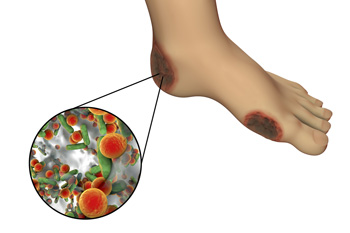 If you experience redness, itchiness, or blisters on the soles of the feet, you may have what is referred to as tinea pedis, or more commonly, athlete’s foot. It is caused by a fungal infection, and is can be extremely contagious. This type of fungus lives and thrives in moist places, and is commonly found in public showers, pools, and surrounding areas. It may affect the area between the toes in addition to the soles of the feet. There are several symptoms of athlete's foot that may be observed, including a rash that may appear, peeling skin on the soles of the feet, or an uncomfortable burning sensation. To prevent this condition from occurring it's suggested to wear appropriate shoes in public places, and to change your socks daily to avoid excessive perspiration between the toes. If you are experiencing chronic or severe athlete’s foot please schedule a consultation with a podiatrist.
If you experience redness, itchiness, or blisters on the soles of the feet, you may have what is referred to as tinea pedis, or more commonly, athlete’s foot. It is caused by a fungal infection, and is can be extremely contagious. This type of fungus lives and thrives in moist places, and is commonly found in public showers, pools, and surrounding areas. It may affect the area between the toes in addition to the soles of the feet. There are several symptoms of athlete's foot that may be observed, including a rash that may appear, peeling skin on the soles of the feet, or an uncomfortable burning sensation. To prevent this condition from occurring it's suggested to wear appropriate shoes in public places, and to change your socks daily to avoid excessive perspiration between the toes. If you are experiencing chronic or severe athlete’s foot please schedule a consultation with a podiatrist.
Athlete’s Foot
Athlete’s foot is often an uncomfortable condition to experience. Thankfully, podiatrists specialize in treating athlete’s foot and offer the best treatment options. If you have any questions about athlete’s foot, consult with one of our podiatrists from Carolina Foot & Ankle. Our doctors will assess your condition and provide you with quality treatment.
What Is Athlete’s Foot?
Tinea pedis, more commonly known as athlete’s foot, is a non-serious and common fungal infection of the foot. Athlete’s foot is contagious and can be contracted by touching someone who has it or infected surfaces. The most common places contaminated by it are public showers, locker rooms, and swimming pools. Once contracted, it grows on feet that are left inside moist, dark, and warm shoes and socks.
Prevention
The most effective ways to prevent athlete’s foot include:
- Thoroughly washing and drying feet
- Avoid going barefoot in locker rooms and public showers
- Using shower shoes in public showers
- Wearing socks that allow the feet to breathe
- Changing socks and shoes frequently if you sweat a lot
Symptoms
Athlete’s foot initially occurs as a rash between the toes. However, if left undiagnosed, it can spread to the sides and bottom of the feet, toenails, and if touched by hand, the hands themselves. Symptoms include:
- Redness
- Burning
- Itching
- Scaly and peeling skin
Diagnosis and Treatment
Diagnosis is quick and easy. Skin samples will be taken and either viewed under a microscope or sent to a lab for testing. Sometimes, a podiatrist can diagnose it based on simply looking at it. Once confirmed, treatment options include oral and topical antifungal medications.
If you have any questions, please feel free to contact one of our offices located in Huntersville Office | 16419 Northcross Dr Suite A, Huntersville, NC 28078; Mooresvillle Office | 206 Joe Knox Avenue Suite D, Mooresville, NC 28117; and Mountain Island | 10310 Couloak Drive Suite 200, Charlotte, NC 28216 . We offer the newest diagnostic and treatment technologies for all your foot care needs.
